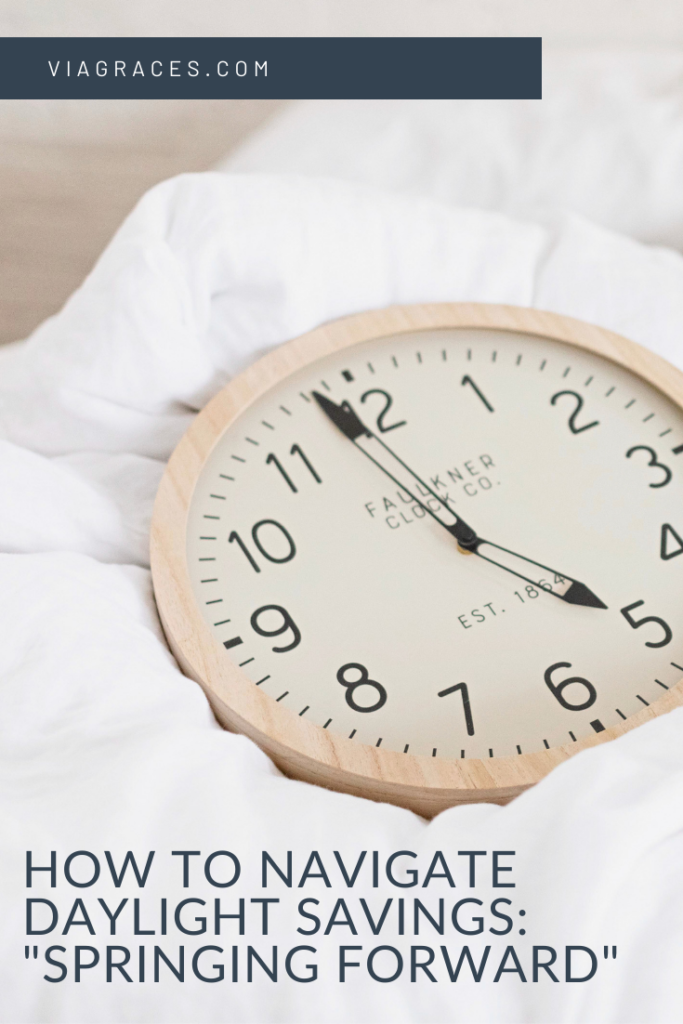Raise your hand if you think daylight saving time should just be done away with! (You can’t see me right now, but my hand is raised high.)
The good news is that “springing forward” isn’t nearly as brutal as “falling back”; the clock will say 8:00 am when you wake up rather than 7:00 am, so yay!
Although I can’t change the overall system of daylight savings, I can help you go into the weekend with a plan to help your child’s sleep stay as on track as possible.
If you’re reading this and thinking, “I usually just wing it and we come out just fine,” (what we always did before I was a sleep consultant), great! We’ll all end up together on the other side after a week or so.
But if you’re already stressing about what to do, don’t worry…we have a plan!
In our house, we usually start with a plan, and then at some point we just kind of wing it because some activity or event throws us off, or one kiddo adjusts quickly while the others are still adjusting. But it still helps me to have some sort of plan and just understand what’s actually happening.
So just to get all of our heads on straight, because it’s confusing…
When we “spring forward,” 8:00 pm on the clock feels like 7:00 pm to our bodies, meaning if we put our child to bed at 7:00, like usual, their body feels like it’s only 6:00 pm, and that probably won’t fly.
So in this blog post I will explain:
- When it’s best to start adjusting your baby or toddler’s sleep for daylight saving time
- How to spring forward with babies on an awake window schedule
- How to spring forward with babies and toddlers on a set nap schedule
- How to spring forward with older kids who no longer nap
- A few tips for your sleep during daylight saving time, too!

When to Start Adjusting Your Child’s Sleep for Daylight Savings
Some people prefer to start adjusting their child’s schedule before daylight savings so that once the clocks change, their little one is adjusted. If that works better for your family or your schedule, go for it!
I simply wait until the time actually changes, wake up like usual that Sunday morning, and then adjust all of the clocks and our schedule from there.
Springing Forward with Young Babies on an Awake Window Schedule
If you have a little one who strictly follows awake windows, then keep following those awake windows!
If you’ve been hoping for a slightly later bedtime, you can use this time change to get there. However, if you’re happy with your child’s current schedule, you can simply cap one of their naps to get them to bed around the same time as usual.
For example, if your 4-month-old usually takes an afternoon nap from 3:30-4:30, wake them up at 5:00 pm (will feel like 4:00 pm) so you can still get them to bed before 8:00. (This is also where having a consistent bedtime routine comes in handy, as it will alert your little one that it’s bedtime!)
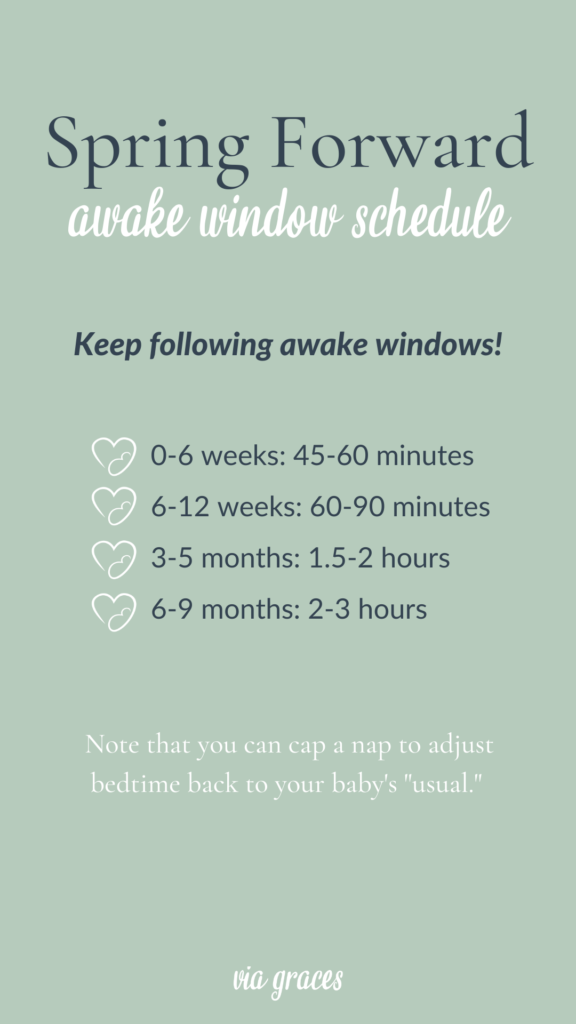
Springing Forward with Babies and Toddlers on a Set Nap Schedule
If you have a baby or toddler takes one or two naps every day and they’re on a clock-based schedule,, your best bet is to adjust your child’s schedule in 15-minute intervals every two days. Here’s what that looks like (and see the chart below for a visual and a screenshot)…
Bedtime
If your child usually goes to bed at 7:00 pm, move bedtime to 7:45 pm on days one and two (Sunday and Monday) – this will feel like 6:45 pm to their body.
Then on days three and four, bring your child’s bedtime forward another 15 minutes, to 7:30, and do the same for naps. On days five and six, move your child’s bedtime forward to 7:15, and by day seven you’ll be back to 7:00 pm.
Do the same for naps!
Bring your little one’s nap forward (according to their body clock) by about 15 minutes every two days until you’re back to your current schedule at the end of the week.
What about mornings?
Like I mentioned before, simply let your little one wake up Sunday morning when they usually do and then start adjusting their schedule from there. Then on day 2, wake them up at 7:45 am (remember, that will feel like 6:45 am) to continue the adjustment. Days 3-4, however, wake them up at 7:30 am as you’ll be pulling their nap forward by 15 minutes. Days 5-6, wake them up at 7:15 am, and day 7 wake them up by 7:00 am.
I know waking up a sleeping child just isn’t fun, but it’s necessary when adjusting their schedule!
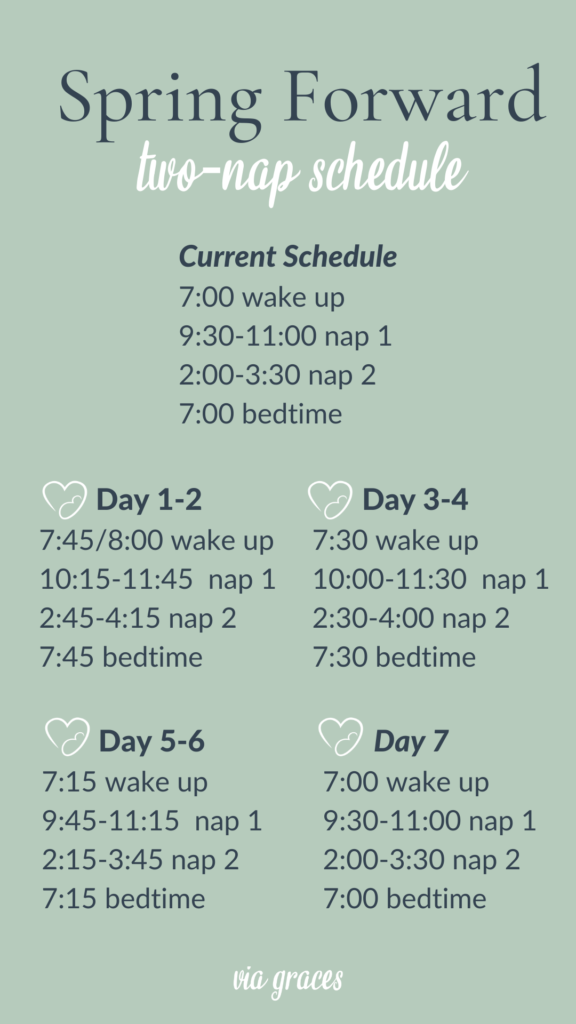
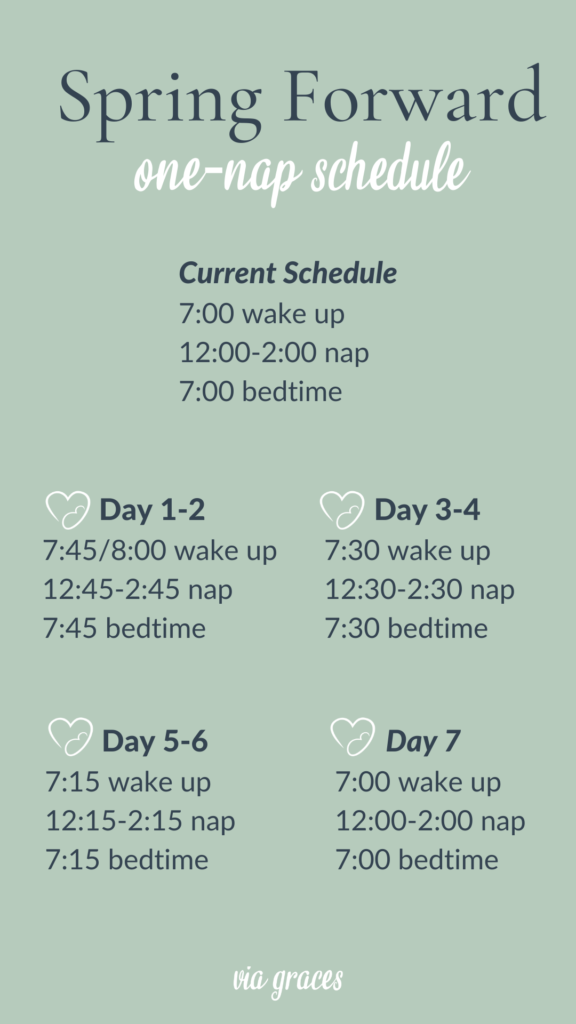
Springing Forward with Children No Longer Taking Naps
If you have an older child who doesn’t nap anymore, I suggest using 30 minute intervals as they won’t be as sensitive to the change.
Bedtime
If your child is usually in bed by 7:00 pm, move their bedtime to 7:30 pm for three days (this will feel like 6:30 pm), then on the fourth day make bedtime 7:00 pm again.
What about mornings?
You’ll adjust mornings similarly, as well, waking your child around 30 minutes early the first few days to help their body clock adjust to the night time change. (See sample schedule below.)
And if you use the Hatch, or a similar toddler clock, make sure you program it according to the time change the night before and continue adjusting it all week with your little one’s schedule!
It’ll take a few more days to fully adjust, but by the end of the week you should be back to normal.
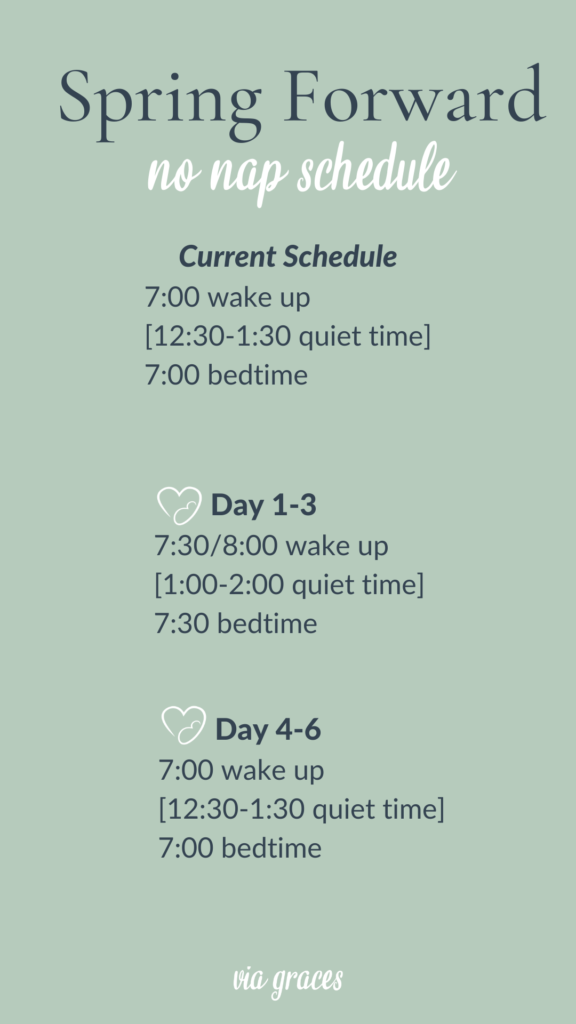
If all of this talk of schedules is overwhelming because your little one’s sleep schedule is already tough to figure out, we have resources for you! If you have a newborn, check out the Three Daily Routines for Newborns freebie for newborn awake windows (and more!). And if your babe is 4-17 months old, the Ultimate Guide to Baby Sleep Schedules is for you!
A Few Tips For Everyone!
Remember that springing forward now means the sun is going to rise earlier. If there is any sunlight starting to creep into your child’s room around 5 or 6 am, that extra light could cause an early morning waking, and we certainly don’t want that.
So make sure your little one’s room is DARK! And I’m talking, “I can’t see my hand in front of my face,” dark. Checkout my favorite blackout solution if you’re anticipating this to be a struggle.
Finally, GET OUTSIDE! Our body clocks can be very sensitive, and even with slight changes in schedules we can get easily thrown off, so make sure both you and your kiddos are getting outside during this adjustment.
Not only does soaking up the sunlight, specifically in the morning and around sunset, help our body clocks adjust (great tip for changing time zones, too!), but it’s one more opportunity to play, play, play and get some extra energy out so we can all sleep well.
Conclusion
If you’re in a state or country that doesn’t do daylight saving time, we’re jealous.
But the goal of this blog post is to give you a PLAN if you are adjusting to daylight saving time!
The plan is, we are springing forward whether we like it or not! And you can have a plan that helps your little one’s body clock adjust to it within about a week. Or for some of you, the plan might be, there is no plan! And that totally works for some.
No one likes time change. We’re all going to be looking at the clock and confusing ourselves trying to do the math all week long. We might forget that we’re adjusting and “mess up a nap time.” The good news is, within about a week or so, we should be back to our normal schedules and you won’t have to do the mental math anymore.
Finally, if daylight savings is the least of your worries when it comes to your child’s sleep and you’d like some help, check out how we can help your whole family get the best sleep possible!
With Grace,
Lauren
Note that this blog post includes an affiliate link, and it’s based on my personal review.
